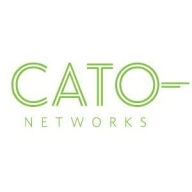

Find out in this report how the two Intrusion Detection and Prevention Software (IDPS) solutions compare in terms of features, pricing, service and support, easy of deployment, and ROI.
Their knowledge portal and Cato Academy portal are excellent resources.
They provide very good technical support.
Our customer service experience is excellent
Fortinet, on the other hand, offers quicker response times and same-day RMAs, which gives them an edge in customer service.
A few years ago, I had a very bad situation. We lost a lot of money, and I opened for the first time in my life, a case with priority one. The person responsible for the ticket didn't respond for two days.
The response was fast, and they provided experts to solve our issues quickly.
As an MSSP, we find it scalable for end users across EPP platforms, network, and cloud sides.
I would rate the stability of the solution as ten on a scale of one to ten.
We have not seen many issues with Cato SASE Cloud Platform recently.
The software situation with Cisco is problematic.
The kind of integrations they offer today, in the future, I would think they would add more and more feature sets, especially around where they remove the dependency of having specialist solutions on a typical monitoring side.
The platform lacks strong security features on the edge.
Incorporating AI capabilities would enhance its functionality.
Graphical interfaces are very nice, but when you've got thousands of objects in a big installation and have to configure many things, CLI is a much faster way to do it.
The features are available for much less than Palo Alto.
The pricing is flexible due to our special partnership with Cato Networks.
It's cheaper to integrate with existing IT security solutions compared to other expensive brands with subscription costs.
It is scalable for end users across network and cloud sides and saves operational costs.
They offer a very lightweight and powerful console where it has everything needed to manage as a service.
Cisco Secure IPS (NGIPS) is quite powerful for threat detection and includes botnet detection.
They can discover new versions of malware, which is very beneficial.
| Product | Market Share (%) |
|---|---|
| Cisco Secure IPS (NGIPS) | 3.4% |
| Cato SASE Cloud Platform | 2.7% |
| Other | 93.9% |


| Company Size | Count |
|---|---|
| Small Business | 14 |
| Midsize Enterprise | 7 |
| Large Enterprise | 10 |
| Company Size | Count |
|---|---|
| Small Business | 26 |
| Midsize Enterprise | 17 |
| Large Enterprise | 26 |
Cato Networks is a leading SASE (Secure Access Service Edge) platform, combining SD-WAN and network security to obtain a cloud-native service. Cato Networks optimizes and secures application access for users and identities. The platform delivers a next-generation secure networking architecture that minimizes legacy IT infrastructures’ complexity, costs, and risks. The goal of Cato Suite is to connect any user to any application securely and optimally.
Cato Suite runs on a private global network of more than 65 PoPs (points of presence) connected via SLA-backed network providers. The service can connect branches, data centers, users, and clouds. Cato can be deployed in stages to augment legacy network services.
Cato Suite delivers end-to-end route optimization for WAN and cloud traffic. The architecture is self-healing, enabling a high service uptime.
Cato Features
Cato Cloud has a global backbone to deliver a reliable, global network. Here are some key SD-WAN features of Cato Cloud.
What challenges does Cato Network solve?
MPLS (multi-protocol label switching) networks are usually expensive and limited in their capacity. Cato simplifies migrating to a faster, higher-capacity internet and SASE cloud. Cato SD-WAN appliances enable customers to improve usable capacity and resiliency.
Customers who suffer from the challenge of high latency and network inconsistency can use Cato to deliver a consistent connection and user experience to access on-premises and cloud applications.
Cato’s complete network security stack connects all branch locations to the Cato cloud, therefore protecting all traffic, both internet-bound and WAN, with enterprise-grade, cloud-based security services. This capability avoids having to backhaul internet traffic to a data center or hub or having to implement stand-alone cloud security solutions.
Organizations using Cato notice an acceleration of cloud traffic. Cato achieves this by routing all traffic from the edges to the PoP closest to the data center. Because of the close distance between the two, the latency is near zero.
Reviews from Real Users
An IT manager/project coordinator at a healthcare company says that “[Cato is] a cloud-based solution that integrates well with everything. They are the classic SaaS solution.”
Yeong-Gi L., a network engineer at Snetsystems, notes that “The solution is very stable. The scalability is quite good. Technical support was always helpful and responsive. The integration capabilities are not a problem at all.”
"The most valuable feature is that it also works as a next-gen firewall because it has security features," says Lorenzo S., senior solutions consultant Lead at MDI.
Cisco Secure IPS (NGIPS) provides intrusion prevention, malware detection, and DDoS protection with modularity, third-party integration, and cloud capabilities, focusing on flexibility, automation, and real-time threat detection, while offering centralized management and ease of upgrading.
Cisco Secure IPS (NGIPS) is designed to support network security through an open platform, delivering features such as anomaly detection and security intelligence. Users benefit from robust technical support, making it a reliable choice for enterprises seeking to protect their network infrastructures. However, improvements are needed in user-friendliness, interface complexity, and integration with third-party tools. There is a demand for better reporting, sandboxing capabilities, and enhanced AI-driven threat detection and response times, especially for zero-day attacks. Pricing remains a concern due to high costs and licensing complexity.
What are the key features of Cisco Secure IPS?Businesses deploy Cisco Secure IPS (NGIPS) in both on-premises and cloud environments, addressing needs like compliance audits and integration with platforms such as Cisco Talos and Umbrella. Its implementation strengthens perimeter security, enhances cybersecurity in enterprise and banking sectors, and ensures effective threat management for network defense.
We monitor all Intrusion Detection and Prevention Software (IDPS) reviews to prevent fraudulent reviews and keep review quality high. We do not post reviews by company employees or direct competitors. We validate each review for authenticity via cross-reference with LinkedIn, and personal follow-up with the reviewer when necessary.